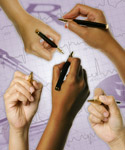May 10th, 2022
“Look at Me …”: The Problem with Clinical Documentation
Khalid A. Shalaby, MBBCh
It was a couple of months into my second year of internal medicine residency. One of my patients canceled a 4 pm appointment. The spot was immediately filled with an urgent visit by another patient in our clinic. I had been working on improving my efficiency in the clinical setting since the start of my residency, and I had fallen into a rhythm of familiarity with our clinic, its staff, and our patients. Swapping a regular visit with an urgent care visit at the last minute was manageable.
I greeted my patient, asked if I could take notes as we talked, and started the visit. I listened during the “golden minute” — when the patient talks, uninterrupted, about what brought him or her to the clinic. The golden minute is a great time to connect with patients, listen attentively, and glean the most useful parts of the history that ultimately leads to an accurate diagnosis and treatment plan. During this time, I was typing on the computer in the examination room, when the patient said these three words: “Look at me.” His words hit me like a ton of bricks.
 The patient wasn’t angry or upset. He said these words graciously. He was merely trying to bring my attention to his hurting joint while I was typing parts of the HPI in an attempt to save time on documentation. I was so disappointed in myself. No patient ever had to ask for my attention while I was in the room since I started interacting with patients in medical school. I set the computer aside, actively listened, and carefully examined my patient.
The patient wasn’t angry or upset. He said these words graciously. He was merely trying to bring my attention to his hurting joint while I was typing parts of the HPI in an attempt to save time on documentation. I was so disappointed in myself. No patient ever had to ask for my attention while I was in the room since I started interacting with patients in medical school. I set the computer aside, actively listened, and carefully examined my patient.
Thankfully, he was my last patient of the day. Even though he was satisfied with the visit and glad to be seen on short notice, his words lingered and weighed heavily in my head. I sat down to reflect. How did I get to that point? How did I unlearn one of the core principles of being a physician, especially when I thought it was one of my strongest suits?
I could have come up with excuses, but they wouldn’t have been true. I was at fault. It dawned on me then that I had been gradually slipping away from patients and toward computers over the previous few months. My job satisfaction had also been declining. I was spending more time with computers and less time with my patients. Helping patients, spending time with them, and building rapport are the reasons I went into medicine.
 How extensive is the problem?
How extensive is the problem?
This issue permeates inpatient and outpatient care. Clinical documentation places a huge burden on all physicians, not just residents. U.S. physicians reported spending close to 2 hours daily completing documentation outside of office hours. This accounted for approximately 125 million hours in 2019 (NEJM JW Gen Med May 15 2022 and JAMA Intern Med 2022; 182:564). Many physicians multitask during their outpatient visits to mitigate the amount of work outside of their office hours. The data on use of computers during clinical encounters is mixed (Patient Educ Couns 2017; 100:50). In one study, more keystrokes during clinical encounters predicted less active patient participation (J Gen Intern Med 2018; 33:423). However, skilled and experienced physicians might still be able to maintain patient-centered communication during clinical encounters while using computers (J Gen Intern Med 2007; 22:43).
Although the burden of clinical documentation is grave, the onus is on healthcare organizations and physicians to honor what we were all taught — patients come first. Even though clinical documentation is indispensable, technology and innovation in electronic health records (EHR) should work for patients and physicians, not the other way around. There have been many local and national initiatives to have fewer clicks on computers, to get rid of unnecessary alerts or messages, and to lessen the burden on clinicians. We should continue those efforts and build upon them.
What practical approaches can we use to prioritize patients?
I do not aim to discourage anyone from documenting during clinical encounters. I just call on myself and my colleagues to be mindful of how it can affect our patients. Not every encounter will be the same. It may be feasible to document in some encounters. There are other appointments when we simply need to pull up a chair, have uninterrupted eye contact, listen carefully, and hold our patients’ hands. Many residents are eager to learn about clinical medicine but minimize the importance of improving their fluency with the EHR. Being proficient and efficient with the EHR is not a luxury but a necessity to deliver good patient care. On a personal level, I recognize that the less time I spend behind a monitor, the more I am able to be present at the bedside.
 There is always room for improvement. So I keep working on my patient-centered communication skills by learning from my co-residents, chiefs, and experienced attendings. I improve my ability to use speech recognition dictation technology, not just for dictation but for navigating the EHR. I customize the tabs on my EHR and add one-click shortcuts for most commonly used orders, which save me a lot of time, particularly on pre-rounding. On the inpatient side, I advocate for bedside rounding using computers-on-wheels. We are able to spend more time with our patients that way while using the computer not just to place orders but to review labs and imaging with patients.
There is always room for improvement. So I keep working on my patient-centered communication skills by learning from my co-residents, chiefs, and experienced attendings. I improve my ability to use speech recognition dictation technology, not just for dictation but for navigating the EHR. I customize the tabs on my EHR and add one-click shortcuts for most commonly used orders, which save me a lot of time, particularly on pre-rounding. On the inpatient side, I advocate for bedside rounding using computers-on-wheels. We are able to spend more time with our patients that way while using the computer not just to place orders but to review labs and imaging with patients.
There is no one formula for success. The most important factor is the dedication to patient-centered care. I for one have vowed never to hear those dreaded words again! I’ll always be looking at my patients.



This problem is systemic one and really not the fault of physicians. And yes, we can do a lot to improve how we communicate with our patients but at the end of the day, we are working under a toxic insurance incentivized system whose sole purpose is documenting for maximum billing and profits while seeing an ungodly number of patients. That’s where the problem starts.
I feel like the EHR is just a symptom that came out of corporate medical greed and not the problem itself.
This challenge that we face as providers has been eloquently summarized. I agree with all your comments about effectively addressing the issue! Great read!